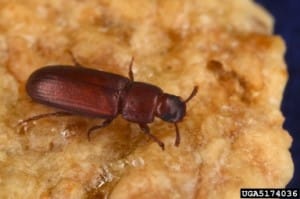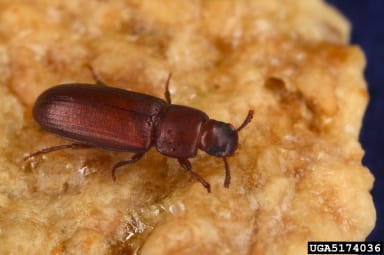Source – Jan Suszkiw in the Southern Region IPM News
Better control of red flour beetles and other costly stored-product insect pests could be on hand, thanks to a new pitfall trap designed by U.S. Department of Agriculture (USDA) researchers.
According to chemist Peter Teal with USDA’s Agricultural Research Service (ARS), the commercial traps now used are typically dome-shaped devices baited with pheromones or other attractants that lure the beetles into pits or onto glue strips. However, the new design, named the “Terrestrial Arthropod Trap,” takes this “fatal attraction” to a new level, adds Teal, who leads the Chemistry Research Unit at the ARS Center for Medical, Agricultural and Veterinary Entomology in Gainesville, Fla.
He co-developed the technology with Lee Cohnstaedt of the ARSCenter for Grain and Animal Health Research in Manhattan, Kan., and Adrian Duehl and Richard Arbogast, both formerly with ARS at Gainesville.

The red flour beetle, Tribolium castaneum, is a primary target of the team’s trap design research because the pest eats both raw and processed cereal grains. It commonly infests flour mills, but can also be found in warehouses, storage bins and household food pantries, causing millions of dollars in losses annually.
Among its features, the new trap is pyramid-shaped and sports slender fins that coax inquisitive beetles into a central pit where they can be captured. The trap is also fitted with light-emitting diodes (LEDs) whose colored light—set to wavelengths of 390 nanometers (nm)—attracts beetles from long distances, ensuring they get a whiff of pheromone as they approach.
In laboratory trials, red flour beetles visited LED traps set to 390 nm approximately 16 times versus two to five times for traps set to other wavelengths. Moreover, the team determined, positioning the LEDs at the trap’s top captured more beetles (approximately 55 total) than placing the diodes at the bottom (12 captured). Combining the LEDs with attractant made the pyramid design even more effective, capturing 70 beetles versus four using a standard dome design.
Read more about this ARS-patented technology in the October 2013 issue of Agricultural Research magazine.
